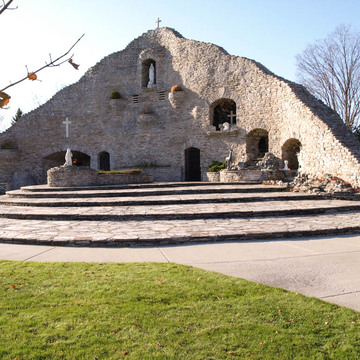The mountainous shrine is dedicated to Our Lady and named to reflect the timberlands surrounding the site that once were occupied by lumberjacks, but now by hunters, fishermen, and tourists. Its Onaway limestone walls are honeycombed with grottos and niches and enhanced with a chapel, wishing well, statues, and stairways. What began as a small shrine, with positive public response and donations, grew into a much larger structure.
The monument rises in a triangular shape from the ground to the peak. Symbolism abounds in every nook and cranny. Niches represent the Straits of Mackinac and Lower Peninsula; the niche representing the Upper Peninsula (UP) is lined with stone from UP quarries. Within the shrine are smaller shrines of the Old World dedicated to Our Ladies of Lourdes, Fatima, LaSalette, and Czestochowa, and of the New World to Our Lady of Guadalupe and Canadian figures. In 1974–1975 the shrine was connected to the newly built St. Mary's Catholic Church.
This beloved vernacular monument contrasts with the equally revered Cross in the Woods at the national Catholic shrine in Indian River, Cheboygan County. The church at Indian River was designed by Alden B. Dow after the Native American longhouse form and dedicated in 1946; the bronze figure of Christ was created by Marshall Fredericks and installed on a huge redwood cross in 1959.


